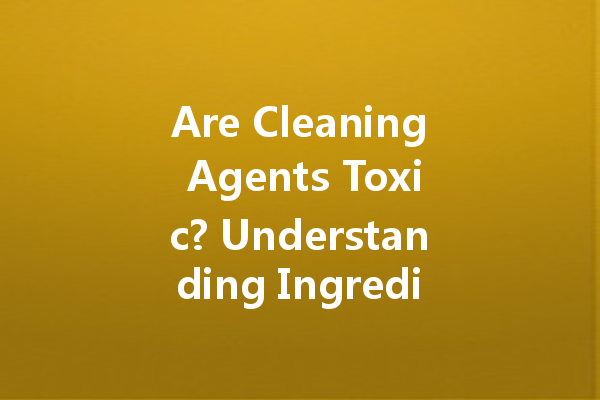Cleaning agents are essential for maintaining hygiene and cleanliness in our homes and workplaces. However, with an increasing awareness of health and environmental issues, many people are questioning the safety of these products. In this article, we will explore the toxicity of cleaning agents, their ingredients, and safer alternatives.
What Are Cleaning Agents?
Cleaning agents, also known as cleaning products or detergents, are substances used to remove dirt, stains, and impurities from surfaces. They are commonly found in households and workplaces, ranging from all-purpose cleaners to specialized products like glass cleaners, carpet cleaners, and disinfectants. Understanding what these agents contain is crucial in determining their safety.
Understanding Toxicity in Cleaning Agents
Toxicity refers to the degree to which a substance can cause harm to living organisms. Many conventional cleaning agents contain chemicals that can be harmful if ingested, inhaled, or absorbed through the skin. Substances such as ammonia, chlorine bleach, and certain surfactants can pose health risks. Symptoms of exposure can range from skin irritation and respiratory issues to more severe effects with prolonged or high-level exposure.
Common Toxic Ingredients in Cleaning Agents
Are Homemade Cleaning Agents Safer?
Many consumers are turning to homemade cleaning agents as a safer, environmentally friendly alternative. Common ingredients like vinegar, baking soda, and lemon juice not only clean effectively but also reduce exposure to harmful chemicals. For example, a simple mixture of vinegar and water can serve as a glass cleaner, while baking soda acts as an abrasive cleaner for tougher stains.
Recipe for a Simple Homemade Cleaner
Ingredients:

Instructions:
Environmentally Friendly Cleaning Agents
In response to safety concerns, many brands are now developing environmentally friendly cleaning products that use natural ingredients and avoid harmful chemicals. These products often carry labels such as “non-toxic,” “biodegradable,” and “phosphate-free.” When shopping, look for certifications from recognized organizations that assess the safety and environmental impact of cleaning agents.
The Importance of Reading Labels
To ensure that you are using safe cleaning products, it is crucial to read the labels carefully. Look for information regarding the ingredients, safety warnings, and proper usage instructions. Avoid products with vague terms like “fragrance” or “cleaning agents,” as these can sometimes mask harmful chemicals.
Conclusion: Staying Informed and Safe
While many cleaning agents are effective at keeping our environments clean, it is important to be mindful of their potential toxicity. By understanding the ingredients and opting for safer alternatives, we can maintain cleanliness without compromising our health or the environment. Whether you choose homemade solutions or environmentally friendly commercial products, staying informed will help you make the best choices for your cleaning needs. Always prioritize health and safety when selecting cleaning agents for your home or workplace.
